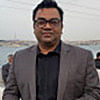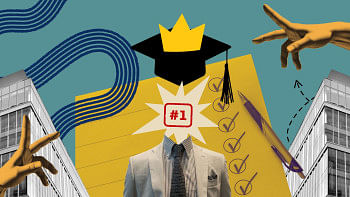Meeting of minds: How Dhaka University became a part of Bose-Einstein legacy

A two-day international conference commemorating the hundred years of Bose-Einstein statistics was curiously labelled as "A legacy of Dhaka." It was organised by the Dhaka University's Department of Physics, so I thought the organisers would probably highlight their department or the institution as the ground zero of the groundbreaking theories of quantum physics. After all, it was during the formative years of the department that Satyendra Nath Bose came up with the revolutionary idea that he shared with Albert Einstein. The correspondence led to the creation of boson particles, resulting in an exponential leap in quantum physics. The Bose-Einstein condensation (BEC) remained a distant reality in the last century due to the particle's requirement for absolute zero temperature. The final endorsement of the hypothesis came when three scientists got the Nobel Prize in Physics in 2001 for "the achievement of Bose-Einstein condensation in dilute gases of alkali atoms and for early fundamental studies of the properties of the condensates." The spotlight once again shifted to an unlikely correspondence between a young teacher at Dhaka University and the maestro of relativity, Albert Einstein.
The celebration of the place intrigued me. Dhaka in the 1920s was no more than a provincial town. The campus was not even considered a proper part of the city centre. "At the outskirts of Dhaka lies the sprawling grounds of Ramna—a splendid site of about 450 acres" (S.N. Bose: The Man and His Work). To think a young reader of this university in his late 20s could reach out to Berlin and offer a solution to a theoretical problem that Einstein was reportedly struggling with is daring, to say the least. But it also shows the promise with which our premier university started and the accomplishments that can be made with the right kind of attitudes and aptitudes.
The celebration of the correspondence between two remarkable physicists of the 20th century allows us to reflect on the glory days of the country's first university, established as an imperial concession. Following the annulment of the Bengal Partition, a Muslim delegation including Nawab Sir Khwaja Salimullah, Syed Nawab Ali Chowdhury, and Sher-e-Bangla AK Fazlul Haq convened with the viceroy to secure their community's educational advancement through the establishment of their own university. The first vice-chancellor, Sir PJ Hartog, explained this political background in the first meeting of its court (later renamed as senate) in 1921. Hartog handpicked his faculty members to ensure that the university developed as a residential and teaching university that is modelled after Oxford. Satyendra Nath Bose was one of its finest recruits whom Hartog personally met in then Calcutta.
The post for a reader was advertised in the famed scientific journal Nature. Bose's classmate from Calcutta University applied for the same job from England, having just finished his Doctor of Science (DSc) degree. Bose was not lucky enough to get any scholarship to travel to Europe, probably due to his strong connection with the Swadeshi Movement earlier. But he did end up coming to Dhaka as a favourite of his department chair Walter Jenkins, who was impressed by an article that Bose had published in the Phil Mag journal. Ironically, it is the rejection of another article by the same journal that prompted him to approach Einstein, which I will describe later.
Let's first reflect on Bose's arrival in Dhaka. He left behind a much more vibrant city and a permanent job at Calcutta University. One incentive was the high salary structure planned by Hartog. The endowment for the newly established university allowed Dhaka to offer double the salary paid in Kolkata. However, this was short-lived, as RK Shanmukham Chetty, the first Indian finance minister, adjusted the allocated fund of Tk 55 lakh with the official buildings given to the university. Consequently, the university had to reduce the salaries of its staff. Bose received a fixed salary of Tk 400 instead of the promised Tk 400-1,200 scale. Within two years, Bose became disillusioned and had to confront the university administration over the injustice. The university was in no way in a position to lose him and gave him a two-year study leave to travel to Paris. But the tension between the right incentives to do research still persists.
While in Dhaka, Bose wrote to his friends, lamenting the lack of current journals and equipment. Later, in Calcutta, he told his students, "We used to live on the moon—do you understand, on the moon!" Indeed, Bose felt left out, as many of his friends by then had travelled to Europe. Dhaka lacked the intellectual milieu of Calcutta. Instead, the green space and gardens gave Bose the peace of mind needed for his research. The garden that he had in his bungalow was proof of his green fingers. He was, however, very happy that the administration was sincere in buying books and journals for the library. He joked that the lab at Dhaka College, run by the White sahibs, had so many dispersed apparatuses that it took extensive research to reorganise them. Walter Jenkins headed the physics department at that time. The teaching team included RN Ghosh and Qazi Motahar Hussain. Bose received courses in thermodynamics and Maxwell's electromagnetic theory. Meghnad Saha served as an external examiner for one of the practical exams. Rumour has it, Saha pointed out the anomaly in one of the recently published papers on quantum theory that he had asked his friend to look into.
In June 1924, Einstein received a letter from an unknown Indian scientist, in which the sender identified himself as a "complete stranger." A follow-up letter contained a five-page article in which Bose addressed a flaw in the quantum theory that Einstein was struggling to solve for some years. Phil Mag had previously rejected the article, prompting a confident Bose to forward it to Einstein for his approval.
Bose shared an extraordinary insight into the behaviour of photons—particles of light—that no one before him had articulated. He argued that photons did not follow the classical Maxwell-Boltzmann distribution, which was the norm for describing the behaviour of particles. Instead, he proposed that indistinguishable particles could occupy the same quantum state, thereby paving the way for a fundamentally new understanding of the quantum world. Einstein did not think Bose was right. But he wrote, "It was a beautiful step forward." He also told his young colleague that he would expand this idea in his own research. Einstein invited Bose from Paris to meet him in Berlin. The two remained intellectually committed.
A century later, there are lessons to be learnt from the way Dhaka became part of the intellectual map of the world. The story of Bose's contribution is not merely one of scientific achievement; it is a testament to resilience, courage, and self-belief. Young people today should find inspiration in this spirit of self-assured conviction, especially those who fear their ideas may not receive the necessary attention or appreciation. Bose teaches us that innovation does not require privilege or fame; it requires vision, passion, and an unyielding faith in one's own ability. And if you can dream, the world is not big enough.
Dr Shamsad Mortuza is professor of English at Dhaka University.
Views expressed in the article are the author's own.
Follow The Daily Star Opinion on Facebook for the latest opinions, commentaries and analyses by experts and professionals. To contribute your article or letter to The Daily Star Opinion, see our guidelines for submission.

 For all latest news, follow The Daily Star's Google News channel.
For all latest news, follow The Daily Star's Google News channel. 











Comments